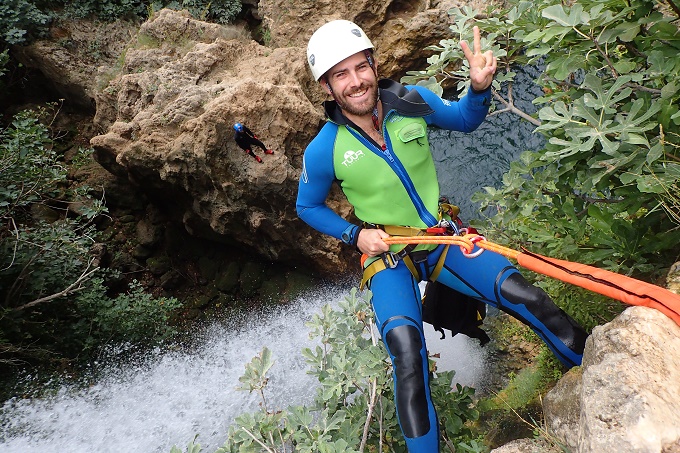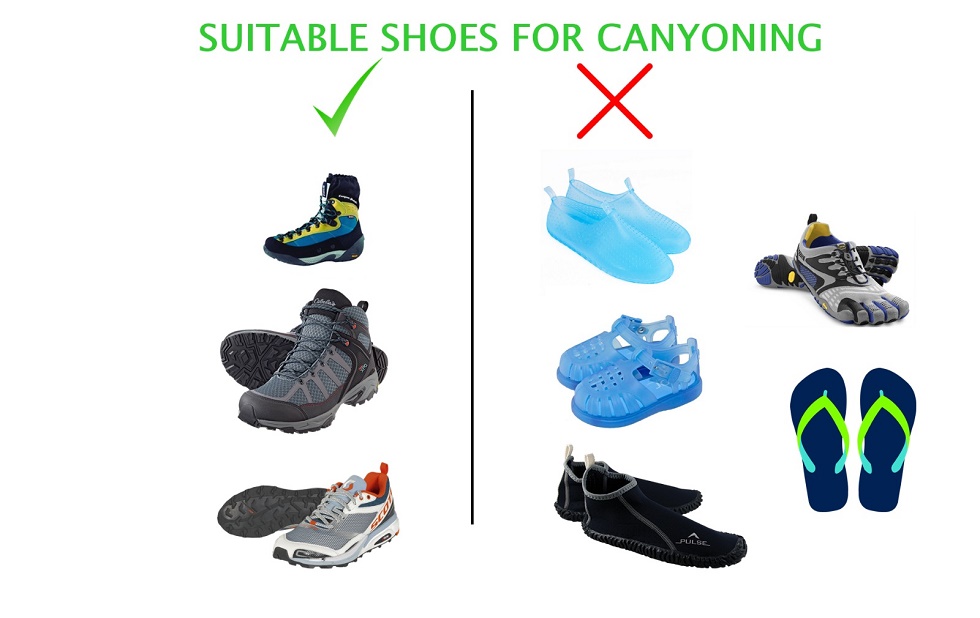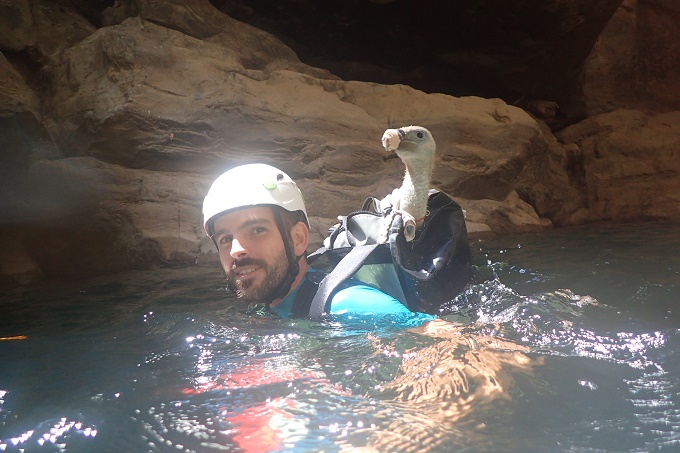To practice canyoning we can distinguish the material that we will use in: personal equipment, which is the basic equipment carried by each of the participants, and the collective equipment, which is the material that normally transports the leader or guide of the group and will serve for the progression and safety of the entire group.
PERSONAL CANYONING EQUIPMENT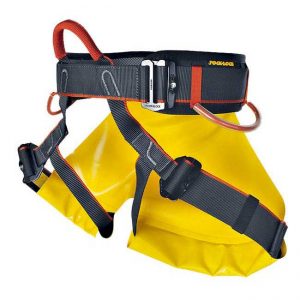
a-Wetsuite (uses and utilities?)
b-Helmet (in case I fall?)
c-Footwear (the best soles)
d-Harness (different options)
e-Baga Anchor (double or single?)
f-Descender (which is the most suitable?)
g-Feeding – Medication
h-Other optional (Backpack, Neoprene Shirt, Whistle, Razor, Waterproof Box and first aid kit, Head Lamp, Food)
The collective team is discussed in a parallel article. Here you can see an index:
Collective team – equipment for the guide
a-Rope (type?, length and thickness ?, possible uses?)
b-Auxiliary rope
c-Backpack (what capacity?, with mushroom?, useful elements?)
d-Waterproof box and what should I put inside
e-Team Maza-Burilador (when?, where?)
f-What should I wear in the harness?
g-What equipment should I carry in my backpack?
Introduction: Personal equipment to practice canyoning
The basic equipment that a participant must carry consists of 6 elements mainly (Neoprene, Helmet, Harness, Anchor Baga, Descender and Footwear). These can be implemented other elements depending on the technical difficulty of the canyon and the experience of the participant, but for basic canyons and normal technical level are not strictly necessary. Other things to consider that would be part of the personal equipment (although it does not have to be carried by the participant) would be; Water, Food and Personal Medication. To the personal equipment can be added; Backpack, Lycra or neoprene shirt, whistle, knife, personal waterproof bottle with first aid kit, front, and various gadgets.
a- NEOPRENE or Neoprene suit (uses and utilities?):
This is a suit similar to diving or surfing that in the case of canyoning it can also be one piece or two pieces. This suit allows us to keep body heat and depending on its thickness will protect us more or less from the cold. If it is a two-piece suit, the chest area will coincide with the waistcoat so we will have double insulation covering the vital organs. The most commonly used two-piece suits are 5mm+5mm which are very versatile as they can be used in complete canyons or colder seasons or just use the dungarees or the combination dungarees + neoprene shirt in the hottest months or canyon. The single body suits are also very comfortable and allow better mobility, although they are less versatile, they are also somewhat more adjustable and tend to enter less water in the jumps.
The wetsuits for canyoning usually have a hood that we will use in the case of facing a winter canyon or thaw water (there are models without hood). They differ from those of diving in that for example they have greater reinforcements in the zone of the knees, elbows and the part of the buttocks since they are zones where we usually lean and help us in the progression. If you are looking to buy a wetsuit we have Seland, a great Spanish brand, which makes high quality suits, although there are other great products such as the multiadventures of Casco Antiguo and others that you can consult.
Canyoning wetsuits don’t just protect us from the cold! It is a generalized idea that only serves us as isolation, but one of its major functions is to protect us from the bumps and small falls against the stones and rocks of the bed of the river. Another of its great functions, which is patent above all in living waters, is that it provides us with great buoyancy. They allow us to float easily in the water, thus saving energy and giving us extra safety in places where there is foam and the density of the water is lower. These are therefore the three main functions of the neoprene: it protects from the cold, from impacts and helps us to float.
b-THE HELMET (In case I fall?):
The different media as well as our different experiences in many mountain sports (mtb, climbing, via ferratas, motorbike …) have made us aware that the helmet is one of the most fundamental elements of the safety of many sports and mountain activities, and for canyoning as well. In this case the popular idea is that the helmet is useful in canyoning when we slip and fall to the ground. But that is not the case. The greatest danger, or the most important function of the helmet in canyoning is to absorb the impact of a stone falling from above in a narrow area of the canyon. It is the same case of protection as in the rock climbing of several lengths when one of the greatest dangers are the stones that fall from the highest part of the summit. The hull also avoids the blows in zones of living waters where we are more at the mercy of the stream of water and in sections where we have to bend down to pass under a rock, cave or siphon. Helmets must be approved for this sport, do not use bicycle helmets or others that are not designed for specific cases of canyoning. Make sure that your helmet has no cracks or have damaged the absorbent elements. A good supervision and control of the material is also necessary. Keep in mind that helmets for rafting or descent of living waters have their own homologation being somewhat different from those of canyoning.
c- THE FOOTWEAR (soles are the best):
Footwear is also one of the fundamental elements of safety in canyoning. Here the sole has the most decisive roll for safety and must be designed to offer the best possible grip on dry, wet or submerged rock surfaces. The best options are professional canyoning footwear which, in addition to having optimum grip, footwear is designed to resist the aggressiveness of this environment and allows water to evacuate more quickly. From TUUR Canyoning we offer the possibility of renting professional canyoning boots. If you do not have the option of renting, another good option is to use a hiking shoe with vibram type sole and lateral reinforcements. Common running shoes are not usually an optimal option as the soles are usually very plasticized and you are going to slip losing a lot of balance (although this option would also be valid and acceptable as long as the footwear is closed). Something that is not permissible at any time is an open footwear such as flip flops, cagrejeras or crocks, as you could easily slip, having your toes hit the rock could crack or fracture a phalanx.
d-THE HARNESS (different options)
The harness in descent of canyon has the peculiarity that has ‘culera’, which is a very resistant plastic canvas that protects the buttocks from chafing. In the progression we are going to use the buttocks a lot to slide on slides, crawl on stones, descending (…) and it is essential not to tear the neoprene. Today there are many harnesses of different brands and qualities that offer simple harnesses up to much more complex harnesses in terms of the carrier material, reinforcements, the area of the ventral ring … We will not go into these details now. Brands such as Signing Rock (with more basic models and others more advanced), Fixe or Petzl (also with different qualities).
e- THE ANCHORING BAGA: Double or simple? Why the anchor baga?
The anchoring baga is an essential element for safe canyoning. It will help you to carry out several important actions; to anchor yourself to pass hands installations, to anchor yourself to meeting points or to anchor yourself to the leader or guide when doing a rappel. Another of the functions of the anchorng baga is to carry out the aids to the companions at the moment of the descending. If the descending is short you can simply grab the karabiner of the anchorage baga to accompany the descent or ascent of your companion. If the descending is longer you can secure the karabiner of the baga to an auxiliary rope and go down accompanying with the rope. Also it is usual to make a knot escape to one of the karabiners of the baga at the moment of securing additionally a rappel (this assurance would do the guide or leader with the auxiliary rope). Thus, the baga has many functions and these are only the main ones.
The anchoring baga must be double and a homologated one is recommended. There are different bags that you can buy like FIXE (somewhat longer) or PETZL (somewhat shorter) but that is to the consumer’s liking. On the other hand, there is controversy about whether homologated or a baga manufactured with a continuous line tied with eight to the ventral ring and fisherman’s knot to type K karabiners. We think that a homologated baga is better if you don’t have enough knowledge and you won’t be able to make an exhaustive and systematic control of this material. We are not going to enter in this controversy although neither everything is white nor everything is black as it is said, only it is necessary to know when, how and why to make a good use and a safe use. Companies must use approved bagas.
f-Descendig (which is the best?): 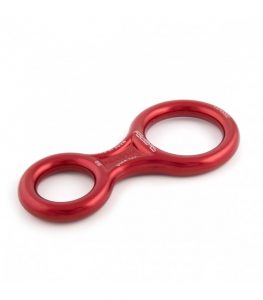
There are many options for descenders and the choice is not easy. To try not to be boring and too extensive in this article we will recommend the most used and perhaps most versatile, the classic eight Fixe. We don’t like to stay in one brand but this one in particular we have to say that it is ideal combined with a karabiner that acts as a brake (useful in some cases and to make safe stops possible). Why? Mainly because of its dimensions. They allow all the options of the other eights that exist with a good braking action but also has the smallest circle of the eight large enough for another karabiner to enter it. This is very useful to facilitate and enable some of the rescue operations. Here is a note: Eights are descenders and insurers that have been used in the past for climbing. Today they are no longer suitable for climbing as they have great disadvantages and little braking action. Remember not to use eights to secure a first or second rope in climbing, if you miss the rope in a fall you won’t be able to stop it. In canyoning it is used for several reasons, one because in many occasions if it is necessary that there is speed in the rappel, the rope can be removed quickly, the rope can also be blocked easily (…) and the eight allows many maneuvers, blocks, lifts, clutches (…)
g- Feeding and Medication:
Although food or medication does not always have to be carried by a participant, we are going to introduce it into the personal equipment as it normally belongs to the participants.
Of course, WATER is essential and it is necessary to provide water for all the activity considering the approach and return that awaits us as well as the duration of the canyon or the temperatures we are going to endure. Also consider that the bigger we are and less accustomed to physical exercise we will need more water. There are some drinking water thermoses that are very interesting when we do expeditions to new canyons and we are not sure if we are going to lack water or we are going to have some setback. We will be able to take water from the river and to drink it with all tranquillity.
Personal medication is also essential, whether asthmatic, diabetic, if you have any allergies (…). Don’t leave it at home and give instructions for its use to your companions at the beginning of the activity in case you get sick!
h- Additional Equipment, optional to the basic-personal equipment:
The following items of equipment are not strictly necessary, as they may be in the guide’s backpack or do not need to be duplicated if the guide has it.
You can also equip yourself with a backpack with a waterproof box in which you can put the sandwiches, an extra front in case the canyoning takes longer than planned, a mobile phone, and an additional rope. All this material can help the group as well as the collective material that the guide must carry.
On the other hand, you can put a whistle that you can put in the helmet and that will be useful to give signals in places where there are waterfalls or give warnings in long distance. And a knife always comes in handy (and I’m not thinking about the 127-hour film…), it’s a tool that can be used in hundreds of situations. The latter you can wear tied to the wrist and inside the sleeve of the neoprene or tied with a fine and longer rope on the bib and placed inside the jacket. If you venture into living waters, it’s best to have it in your sleeve and as close to your hand as possible.
Another complement that we can recommend is the neoprene shirt, elastane and polyamide (…) can be a very useful garment to have on the team. It can be an extra layer in cold canyons, or an intermediate garment to combine with the dungarees in canyons in which the jacket is not necessary, is a good investment and there are very attractive models for both girls and boys.
Enjoy a good team! In a next article we will talk in detail about COLLECTIVE EQUIPMENT.
TUUR Canyoning © 2019







